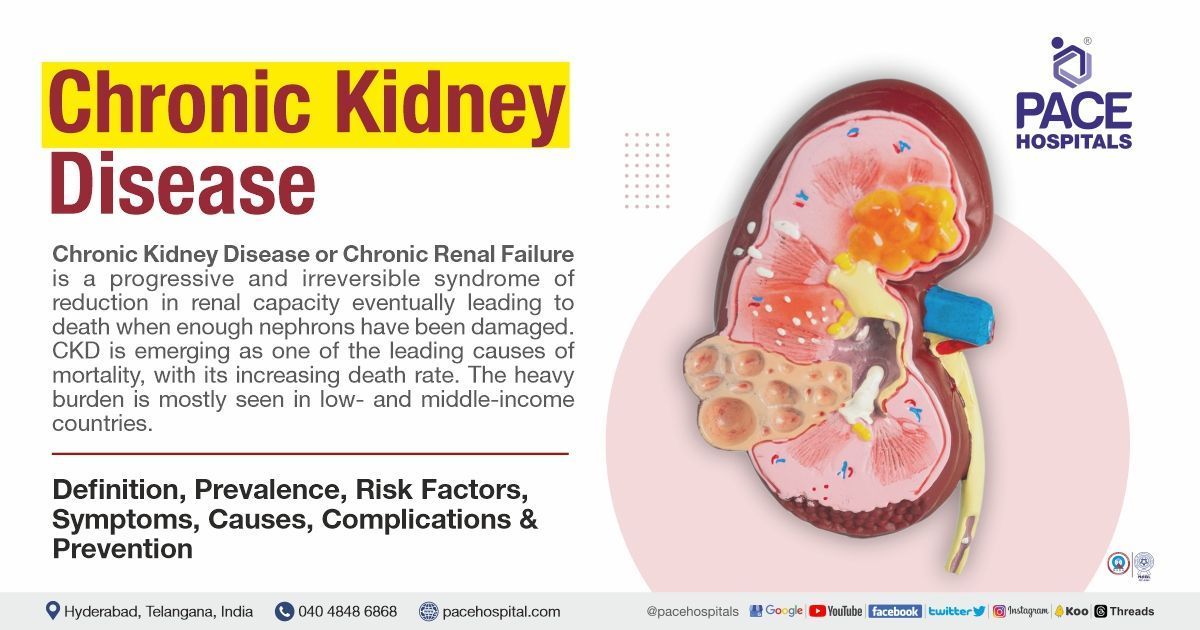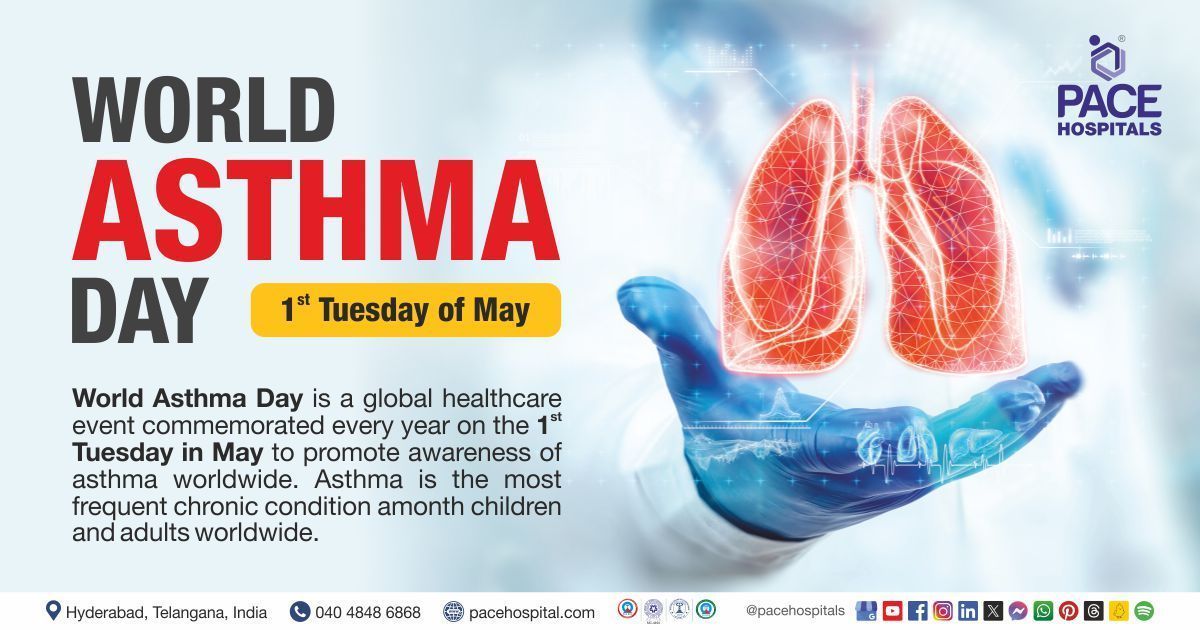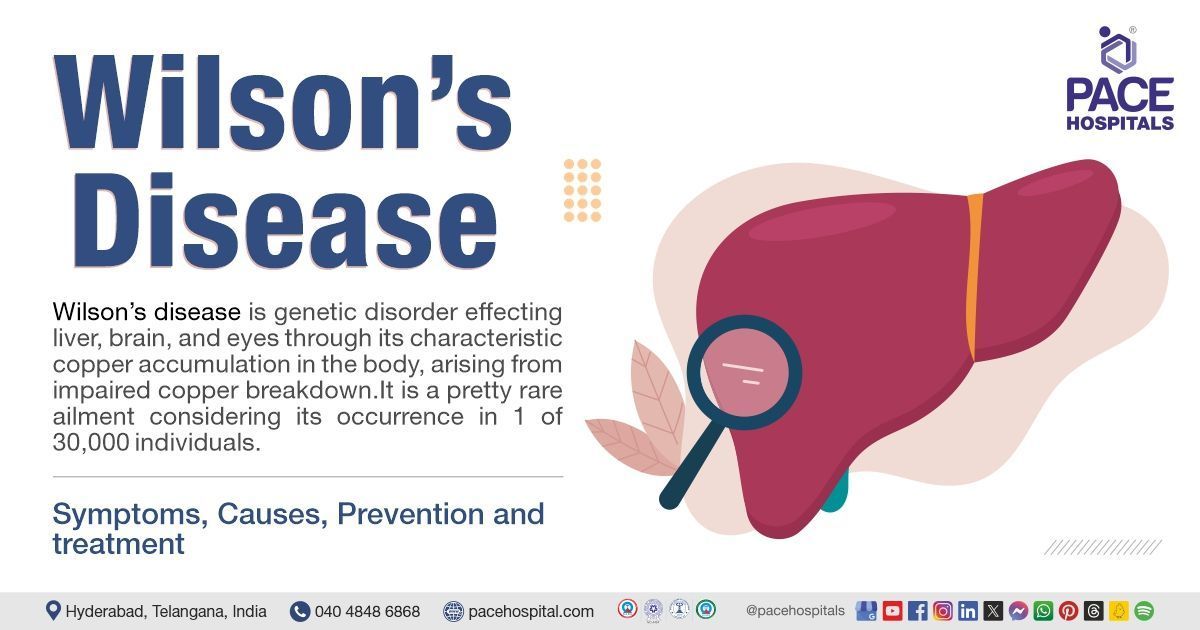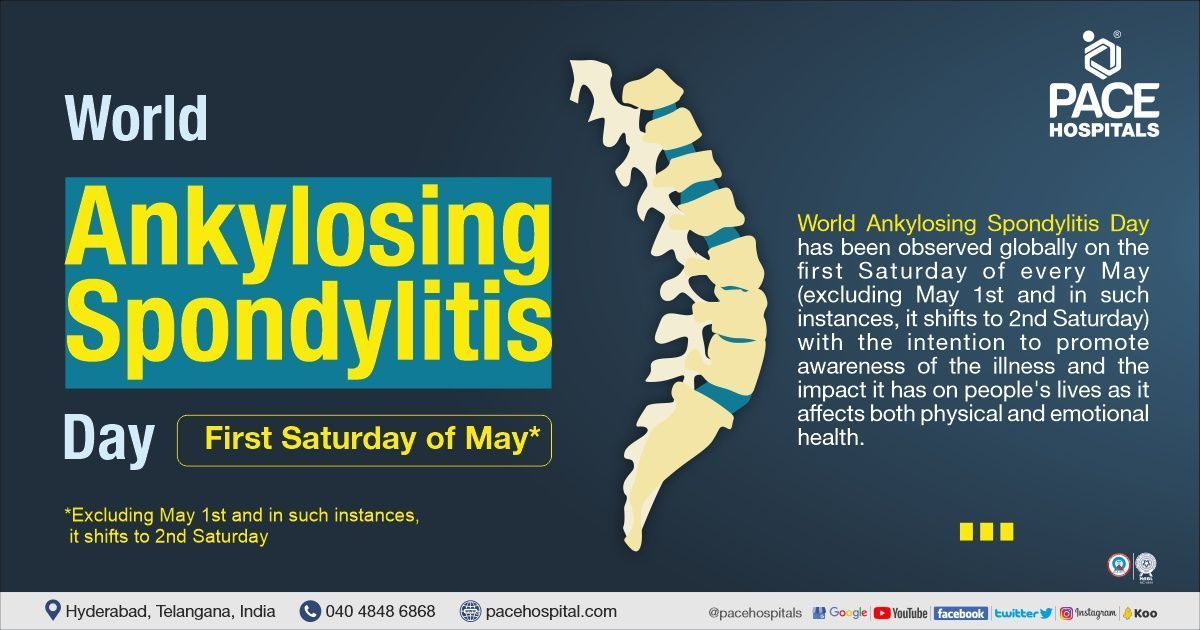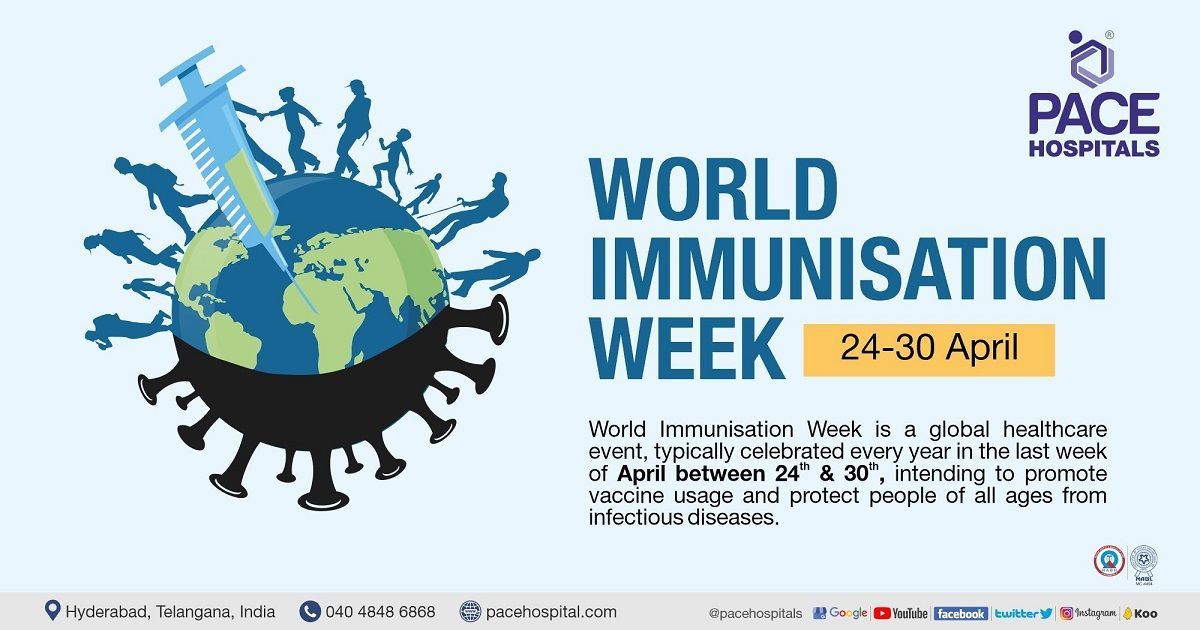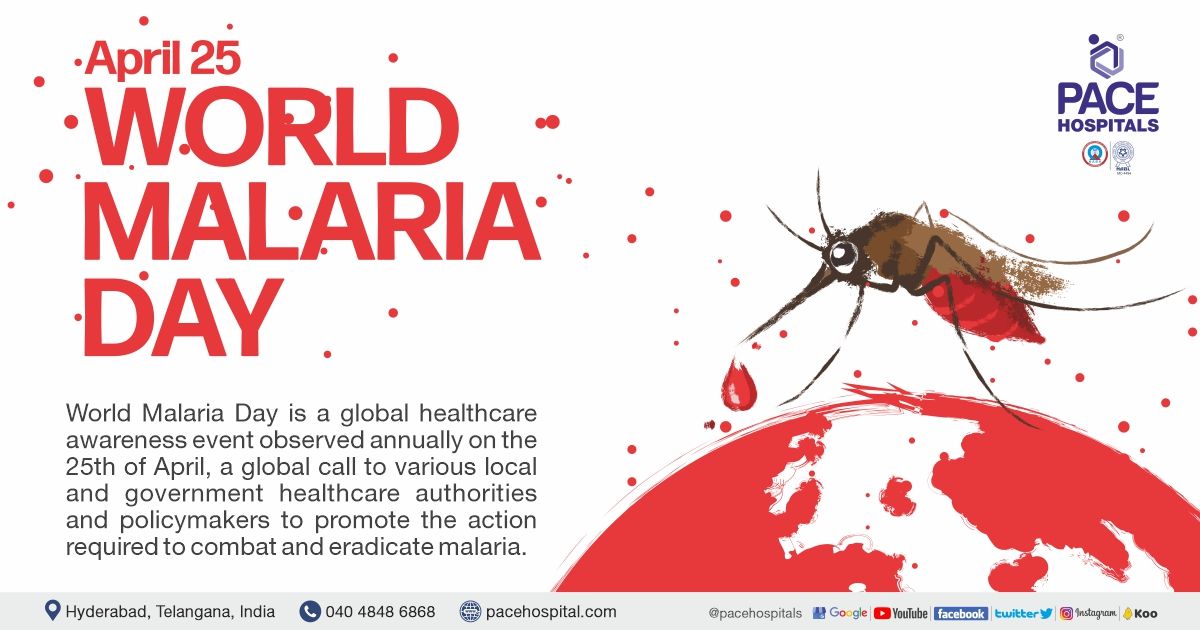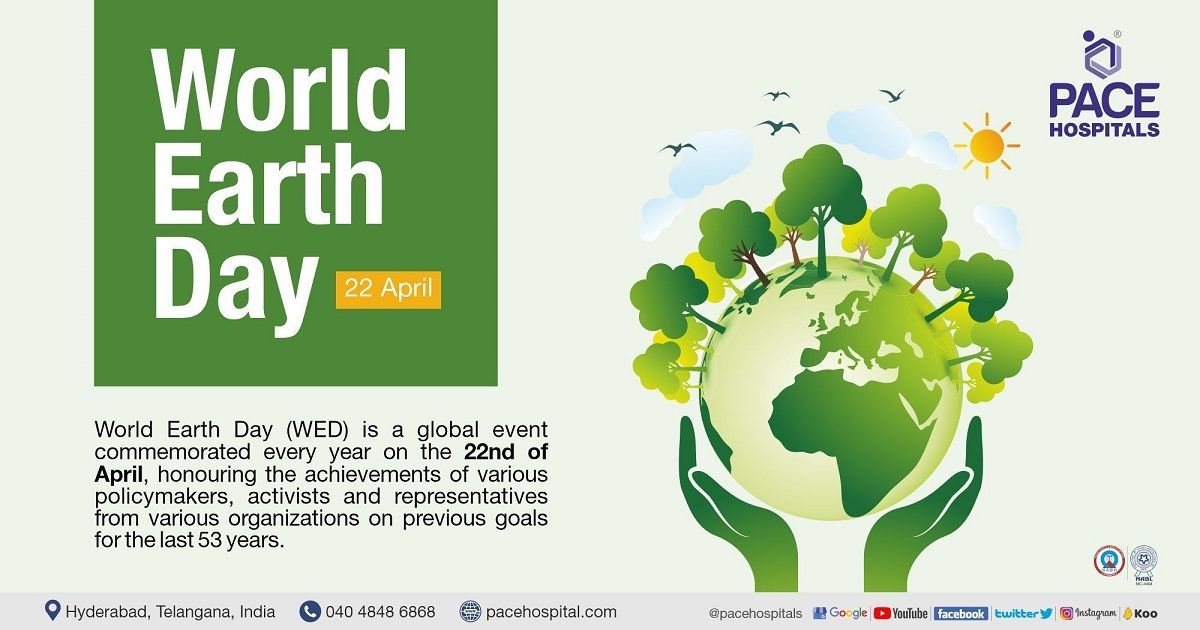Chronic Kidney Disease - Symptoms, Stages, Causes, Complications, Prevention
Chronic Kidney Disease definition / meaning
Chronic Kidney Disease (CKD) / Chronic renal failure is a long-term (chronic) condition comprised of progressive and irreversible deterioration of renal capacity due to slow destruction of renal parenchyma (the kidney), the kidneys gradually lose their ability to filter blood. This can lead to a buildup of waste products and fluids in the body, which can cause a variety of health problems, eventually leading to death when enough nephrons (the functional unit of the kidney) have been damaged.
The most common causes of CKD are diabetes and high blood pressure. CKD is often asymptomatic in the early stages. Acidosis (condition of increased acid in the body fluids) is the major problem in chronic kidney disease, with the development of biochemical azotaemia (build-up of nitrogenous products in the blood) and clinical uraemia syndrome.
CKD full form in medical terms - Chronic Kidney Disease
Chronic kidney disease, another name for chronic renal failure. Although the medical term CKD/ chronic kidney disease/ chronic renal failure hadn’t been coined, throughout the older history, its symptoms such as pyuria (pus in the urine), pain and fever, had been edified in Greek and Roman antiquity. Only in the 18th century, after proteinuria (protein in urine – an abnormal condition) was discovered, the work on CKD accelerated, especially with Dr Bright, who in 1827 demonstrated the first, nearly complete clinical description of acute and chronic glomerulonephritis (inflammation of glomerulus) and the macroscopic differences seen in the kidneys.
Global prevalence of Chronic Kidney Disease (CKD)
More than 10% of the world's population (>80 crores individuals, especially with older and diabetic populations and hypertension) in the world are suffering from the progressive condition of chronic kidney disease or CKD.
As CKD is emerging as one of the leading causes of mortality, with its increasing death rate in the last two decades, its heavy burden is mostly seen in low- and middle-income countries.
Prevalence of CKD in India
Chronic Kidney Disease (CKD) patients pose a significant public health problem due to its high morbidity, prevalence, and mortality.
- Hosting around 17% of the Earth’s population with a little over 3% of global land mass, India faces challenges in providing access to healthcare.
- While the International Society of Nephrology’s Kidney Disease Data Centre Study demonstrated a 17% prevalence of CKD among Indians, the majority of the patients approach the healthcare personnel when their estimated glomerular filtration rate (eGFR) is <15 ml/min per 1.73m2.
- High levels of prevalence are seen in parts of Andhra Pradesh, Goa, and Odisha.
Chronic Kidney Disease - CKD Symptoms
Many Chronic Kidney Disease (CKD) patients are asymptomatic and usually find it through chance findings from regular screening tests, usually through a routine medical examination or until they become unwell due to advanced CKD.
However, depending on the cause, in a few CKD patients, the symptoms are seen due to impaired kidney function. As CKD progresses, kidney function becomes less effective and uraemic toxins accumulate in the body.
These uraemic toxins not only help in the progression but also influence either directly or indirectly influence biochemical and physiological effects in CKD patients, contributing to immune dysfunction, vascular disease, platelet dysfunction and increased bleeding risk, dysbiosis in the gut (imbalance” in the gut microbes), altered drug metabolism. A few of the chronic renal failure symptoms can be seen below:
- Pallor (an unhealthy pale appearance) is usually due to anaemia from CKD.
- Shortness of breath is due to fluid overload, anaemia, cardiomyopathy etc.
- Itching is usually due to uremic toxins and the deregulation of the immune response.
- Cramps are typically worse at night due to neuronal irritation caused by biochemical abnormalities in CKD patients.
- Cognitive changes are seen in CKD patients, and skills decline at different rates. Language and attention may be particularly affected.
- Gastrointestinal symptoms such as anorexia (an eating disorder of obsessing overweight and intake), vomiting, and taste disturbance may occur in advanced CKD patients.
- The caretakers may notice uraemic breath in advanced CKD patients due to the breakdown of urea by saliva.
- Change in urine output, such as polyuria (more urination) due to impaired tubular concentration, oliguria (small amounts of urine), nocturia (urine during the night), and proteinuria (protein in urine).
- Haematuria (blood in urine)
- Peripheral oedema (swelling in your lower legs or hands) due to renal sodium retention.

Causes of CKD - Chronic Kidney Disease
The pathophysiology of CKD or chronic renal failure (CRF) could potentially include almost all chronic nephropathies. The diseases leading to CRF can generally be classified into two major groups: those causing glomerular pathology and those causing tubulointerstitial pathology.
Diseases causing glomerular pathology
Several glomerular diseases associated with CKD patients originate from immune system disturbances. Glomerular destruction changes in the filtration process, leading to nephrotic syndrome. Examples of glomerular diseases are chronic glomerulonephritis (glomerulus inflammation), membranoproliferative glomerulonephritis, lipoid nephrosis, systemic lupus erythematosus, etc.
Diseases causing tubulointerstitial pathology
Tubulointerstitial damage alters the reabsorption and secretion of important constituents, which leads to large volumes of diluted urination. A few of the tubulointerstitial conditions are nephrosclerosis, chronic pyelonephritis, chronic renal infection, drug toxicity, and chronic obstruction such as stones, blood clots, tumours, enlarged prostate etc.
Major causes of CKD - Chronic Kidney Disease
Nearly 45% of incident kidney failure is attributed to diabetes, and another 20% is attributed to chronic hypertension. The five major causes of CKD accounting for >90% of the burden are listed below:
- Diabetic nephropathy
- Glomerulonephritis
- Hypertension-associated CKD such as:
- Vascular and ischemic kidney disease
- Primary glomerular disease with associated hypertension
- Autosomal dominant polycystic kidney disease
- Cystic and tubulointerstitial nephropathy
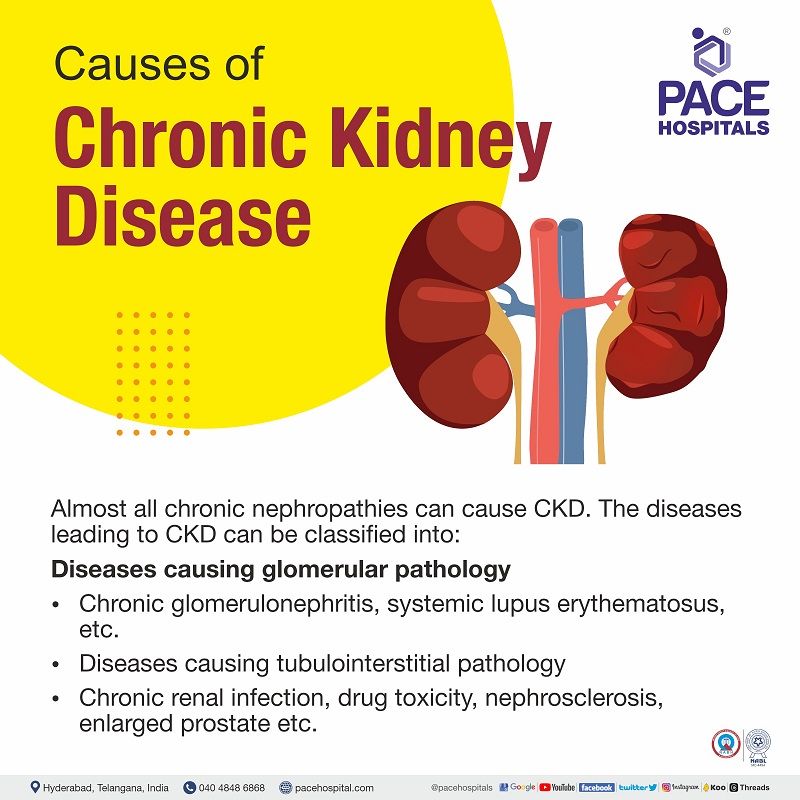
Chronic Kidney Disease - CKD stages
There are five (5) stages in the kidney disease. Stage of kidney disease is determined by the glomerular filtration rate (GFR) and the presence of kidney disease. Glomerular filtration rate is the measure of kidney function. As Chronic kidney disease progresses GFR decreases. Treatment of chronic kidney disease patients is based on stage of the disease.
| Stage | Description | Glomerular filtration rate (GFR) |
|---|---|---|
| 1 | Kidney damage (e.g., protein in urine) with normal GFR | 90 or above |
| 2 | Kidney damage with mild decrease in GFR | 60 to 89 |
| 3A | Moderate decrease in GFR | 45 to 59 |
| 3B | Moderate decrease in GFR | 30 to 44 |
| 4 | Severe reduction in GFR | 15 to 29 |
| 5 | Kidney failure | Less than 15 |
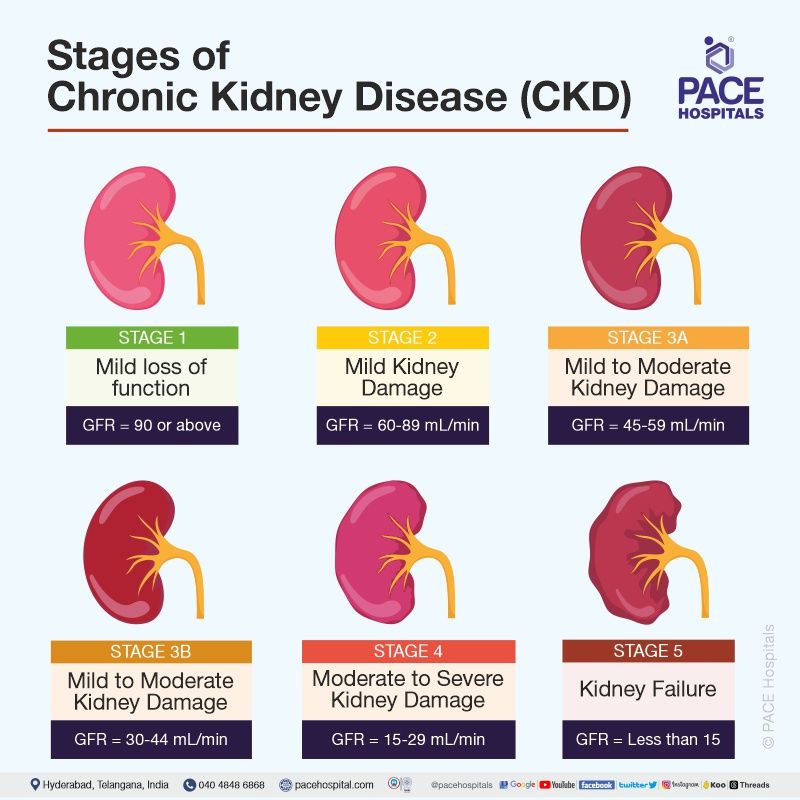
Risk Factors for CKD - Chronic Kidney Disease
There has been significant recent progress in the identification of risk factors that increase the risk for chronic kidney disease, even in individuals with normal glomerular filtration rates.
Adults with such risk factors must get screened at least every two years for albuminuria (increased albumin in the urine) and blood pressure abnormalities to arrest CKD development. The various risk factors which can influence contracting CKD include:
Chronic Nonrenal (Systemic) Disease
- Diabetes, hypertension, and metabolic syndrome – Through obesity, dyslipidaemia, insulin resistance, and oxidative stress, the pathogenesis of CKD is seen with diabetes and metabolic syndrome.
- Autoinflammatory disease - CKD could occur due to the effector responses which target the kidneys.
- Infections (e.g., HIV, HBV, HCV) – Apart from direct infection of renal parenchyma, microbes can induce CDK through 3 paths:
- Kidney complications due to liver disease.
- Drug-induced CKD.
- Glomerular immune complex deposition.
- Nephrotoxic exposure (including many antineoplastic therapies)- Various proponents of chemotherapies cause nephrotoxicity, which can induce CKD with long-term use.
Demographical and genetical factors
- Age and gender – A 2022 study demonstrated that although female CKD patients are more prevalent, the majority of male CKD patients receive kidney replacement therapy as the mean glomerular filtration rate in women was slower than in men among the elderly and the middle-aged population. Usually, CKD patients are the elderly.
- Family history - Genetic research demonstrated that predisposition to common complex diseases due to DNA sequence variants at several genetic loci are associated with CKD.
Childhood and Adolescent States and Diseases
- Premature birth - Due to decreased nephrons and post-natal exposure to nephrotoxins, premature infants are at a higher risk of chronic kidney disease.
- Treated childhood cancer - Due to unknown reasons in certain cases, adult survivors of childhood cancer could have a higher risk of CKD.
- Lifestyle factors such as smoking, alcoholism, and low physical activity could increase various proponents, which could increase BMI, hypertension, and metabolic diseases, which can increase the chances of CKD.

Complications of CKD - Chronic Kidney Disease
The complications of chronic renal failure could display through various clinical manifestations due to uraemic syndrome. The complications of chronic kidney disease are divided into primary (renal) uraemic manifestations and secondary (systemic or extra-renal) uraemic manifestations based upon the locality.
Primary uraemic (renal) manifestations develop slowly, deteriorating the renal function and resulting in:
- Metabolic acidosis - Renal dysfunction causes acid-base imbalance resulting in metabolic acidosis, causing hyperkalaemia (increased potassium in the blood) and hypercalcaemia (increased calcium in the blood).
- Hyperkalaemia - Excessive accumulation of potassium in the blood since potassium excretion is hampered, causing cardiac arrhythmias, weakness, nausea, etc.
- Sodium and water imbalance - Due to renal dysfunction, sodium and water cannot pass sufficiently into Bowman’s capsule leading to their retention. The main symptoms are hypervolaemia and circulatory overload with congestive heart failure.
- Hyperuricaemia - Excess levels of uric acid in the blood lead to its progressive deposition in joints and soft tissues resulting in gout disease.
- Azotaemia - Protein metabolism results in the production of waste products (urea, creatinine, phenols and guanidines), but since the kidney is redundant, they are circulated in the body.
Secondary uraemic (extra-renal) manifestations usually develop due to the fluid-electrolyte and acid-base imbalances resulting in:
- Anaemia - Decreased production of erythropoietin (a hormone for blood) causes a decline in erythropoiesis (red blood cell production), resulting in anaemia.
- Nephrogenic fibrosing dermopathy - A very rare condition of progressive integumentary induration (skin hardening), especially on the arms and legs.
- Congestive heart failure - Since fluid retention causes hypervolaemia (increased fluid in the body) and therefore increased workload on the heart, it eventually leads to congestive heart failure.
- Pulmonary congestion (condition of fluid in the lungs) - due to the back pressure caused by hypervolaemia and heart failure, pulmonary congestion is caused.
- Mucosal ulcerations - Azotaemia is directly involved in mucosal ulcerations in the lining of the stomach and intestines. The subsequent bleeding can aggravate anaemia.
- Renal osteodystrophy - In extreme renal dysfunction, the drastic changes in minerals and hormones cause the weakening of bone and are in your blood. The main signs are bone pain and fractures.
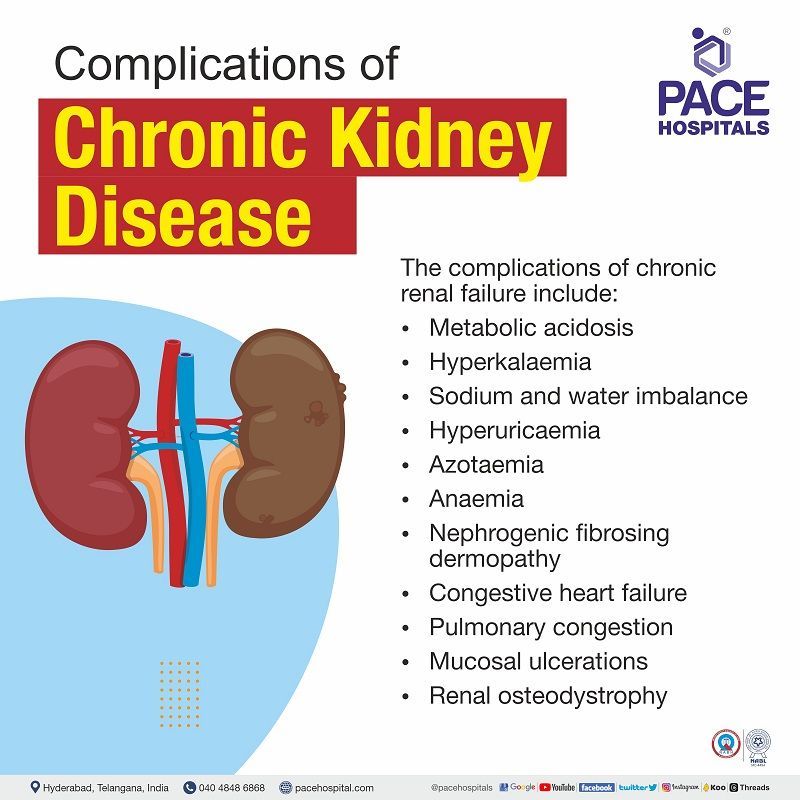
Prevention of CKD - Chronic Kidney Disease
Avoiding exposure to various proponents which cause disease is necessary as prevention is more effective than cure. In this particular disease - Chronic Kidney Disease (CKD), the treatment plan also consists of various dietary and lifestyle adaptations that diametrically help in reducing the ailment.
- CKD diet: The dietary factors which can reduce the risk of CKD are dairy products, fibre, folate, cereal fibre, coffee, legumes, magnesium, nitrate, plant protein, omega-3, nuts, legumes, docosahexaenoic acid (DHA), eicosapentaenoic acid (EPA), vitamin B12, vitamin C, vitamin D, vitamin E, and zinc. Vegetable intake is associated with greater levels of potassium, resulting in lowering chances of CKD.
- Physical exercise: Met analysis of 9 studies demonstrated the lowering of odds of CKD contraction with higher physical exercise when compared with those who were less physically active.
- Smoking: When compared with those who haven’t smoked, former and current smokers face an increased risk of incident CKD. Tobacco smoking leads to insulin resistance and, ultimately, CKD. Avoidance of smoke can prevent kidney disease as well as cardiovascular disease.
Chronic Kidney Disease - CKD diagnosis
Chronic kidney disease (CKD) is diagnosed with a combination of blood tests, urine tests, and imaging tests, including:
- Physical examination and history taking
- Kidney assessment tests (both serum and urine tests)
- Imaging tests
- Chronic renal failure ultrasound (Ultrasonography)
- Renal doppler in chronic kidney disease (Doppler ultrasonography)
- Intravenous urography (IVU)
- Computed tomography (CT)
- Magnetic resonance imaging (MRI)
- Magnetic resonance angiography (MRA)
- Nuclear medicine investigations
The stage of CKD is determined by the GFR. The GFR is divided into six stages, with stage 1 being the least severe and stage 5 being the most severe.
CKD - Chronic Kidney Disease treatment
The goal of CKD treatment is to slow the progression of the disease and maintain a good quality of life. With proper care, many people with CKD can live long and healthy lives. The treatment of CKD can be summarised as:
- Reverse or arrest the process causing the renal damage.
- Prevention of conditions that might worsen renal failure.
- Treatment of CKD symptoms and its secondary complications.
- Chronic kidney disease dialysis and transplantation.
AKI vs CKD | Acute Kidney Failure vs Chronic Kidney Disease
While both AKI and CKD depict kidney diseases, the difference lies in the severity of the conditions. AKI, previously called as acute renal failure (ARF) or acute kidney failure and by 2021, KDIGO redefined it. (Kidney Disease: Improving Global Outcomes).
The sudden reduction in kidney function - acute kidney injury (AKI) is a reversible condition. Chronic Kidney Disease (CKD), on the other hand, is progressive in nature with irreversible deterioration of renal function due to slow destruction of renal parenchyma. The other differences include:
| Characteristics | Acute kidney injury (AKI) | Chronic kidney disease (CKD) |
|---|---|---|
| Onset | Sudden onset | Insidious onset |
| Reversibility | Reversible | Irreversible |
| Causes | Could be prerenal, renal and post-renal causes | Chronic nephropathies can eventually lead to CKD |
| Symptoms | Low or no urine volume, haematuria, thirst, dehydration, flank pain etc | Patients are usually asymptomatic till advanced stage |
CKD vs ESRD | Chronic Kidney Disease vs End-Stage Renal Disease
Both End-Stage Renal Disease (ESRD) and Chronic Kidney Disease (CKD) depict serious kidney diseases. Depending upon the estimated glomerular filtration rate (eGFR), CKD can be divided into five stages. ESRD is the last stage of CKD. The other differences include:
| Characteristics | Chronic kidney disease (CKD) | End-stage renal disease (ESRD) |
|---|---|---|
| Defined by | Glomerular filtration rate less than 60 mL/min/1.73m2 | Glomerular filtration rate less than 15 mL/min/1.73m2 |
| Progresses to | End-stage renal failure (ESRF) | Death |
| Symptoms | Usually, CKD patients are asymptomatic until they reach advanced stage | High BP, unresponsive to medication, anaemia, mineral and bone disorders, etc |
| Causes | Diabetes, metabolic disorders etc | Uncontrolled CKD |
FAQs (frequently asked questions on Chronic Kidney Disease (CKD))
-
What is Chronic kidney disease (CKD)?
Chronic kidney disease (CKD) is a progressive and irreversible renal syndrome with slow deterioration of renal function and renal tissue due to various factors (usually by diabetes, metabolic syndrome etc). It causes azotaemia (buildup of nitrogenous products in blood).
-
Is chronic renal failure and chronic kidney disease the same?
Yes, chronic renal failure and chronic kidney disease are the same. In abbreviated form, it can be called CRF and CKD.
-
Can Chronic kidney disease (CKD) be cured?
No, Chronic kidney disease (CKD) may not be cured by medications, but a renal transplantation may cure it. Since CKD causes progressive damage to the body (through various complications), prompt identification and treatment of the cause of CKD helps.
The life of CKD patients can be extended with dialysis, but CKD can be cured with proper kidney transplantation. It offers the best potential for complete rehabilitation because dialysis replaces only a small fraction of the kidneys ‘function, such as filtration and none of the other renal functions, including endocrine and anti-inflammatory effects.
-
How to increase HB in CKD patients?
A normocytic, normochromic anaemia is observed as early as stage 3 CKD and is almost universal by stage 4. The primary cause is insufficient production of erythropoietin (EPO) by diseased kidneys. The nephrologist may opt for iron supplementation, erythropoiesis-stimulating agents (ESAs), prolyl-hydroxylase inhibitors of endogenous hypoxia-inducible factors (HIFs) etc.
-
Is CKD reversible?
No, CKD is irreversible. Eating potassium-rich vegetables, regular exercise and abstinence from smoking are a few of the common steps in avoiding CKD.
-
Can CKD patients eat curd?
Yes. Various dairy products are among the dietary proponents which can be consumed to stop the progression of CKD or avoid it altogether. Along with dairy products fibre, folate, cereal fibre, coffee, legumes, magnesium, nitrate, plant protein, omega-3, nuts, legumes, docosahexaenoic acid (DHA), eicosapentaenoic acid (EPA), vitamin E, viatmin B12, vitamin D, vitamin C, and zinc also help in arresting the progression of CKD.
-
Why anemia occurs in chronic renal failure?
Anaemia is commonly seen in chronic renal failure as the deterioration of renal function stops the production of erythropoietin. Erythropoietin is a hormone which aids in erythropoiesis (production of red blood cells). To counter it, the nephrologist may opt for iron supplementation, erythropoiesis-stimulating agents (ESAs), prolyl-hydroxylase inhibitors of endogenous hypoxia-inducible factors (HIFs) etc.
-
What causes chronic renal failure?
There are various causes of chronic renal failure, but the five major causes include: glomerulonephritis, diabetic nephropathy, hypertension-associated CKD, autosomal dominant polycystic kidney disease and cystic and tubulointerstitial nephropathy.
-
How does chronic renal failure affect the respiratory system?
Chronic renal failure affects the respiratory system by systematically changing homeostasis.
Of the many complications of chronic renal failure, systemic alteration of fluid homeostasis is prominent. Changes in vascular tone and acid-base balance are also seen following the fluid homeostasis alteration. These alterations occur at a systemic level, influencing various other organs and affecting the respiratory system.
These alterations result in the development of pulmonary congestion, ventilatory control, capillary stress failure and ultimately, pulmonary vascular disease in the lungs.
-
What are the causes of CKD in young adults?
Usually, at least in 73% of End-stage kidney disease patients, the congenital anomalies of the kidneys could be the origin point. One-third of diagnoses include glomerulonephritis and focal segmental glomerulosclerosis accounting for patients older than 12 years of age.
As adolescents are contracted CKD, various factors such as metabolic acidosis, decreased caloric intake, and metabolic bone disease cause a reduction in gonadal hormone production, growth hormone resistance, etc which could delay puberty.
Request an appointment
Fill in the appointment form or call us instantly to book a confirmed appointment with our super specialist at 04048486868
Appointment request - health articles
Thank you for contacting us. We will get back to you as soon as possible. Kindly save these contact details in your contacts to receive calls and messages:-
Appointment Desk: 04048486868
Whatsapp: 8977889778
Regards,
Pace Hospitals
Hitech City and Madinaguda
Hyderabad, Telangana, India.
Oops, there was an error sending your message. Please try again later. We will get back to you as soon as possible. Kindly save these contact details in your contacts to receive calls and messages:-
Appointment Desk: 04048486868
Whatsapp: 8977889778
Regards,
Pace Hospitals
Hitech City and Madinaguda
Hyderabad, Telangana, India.
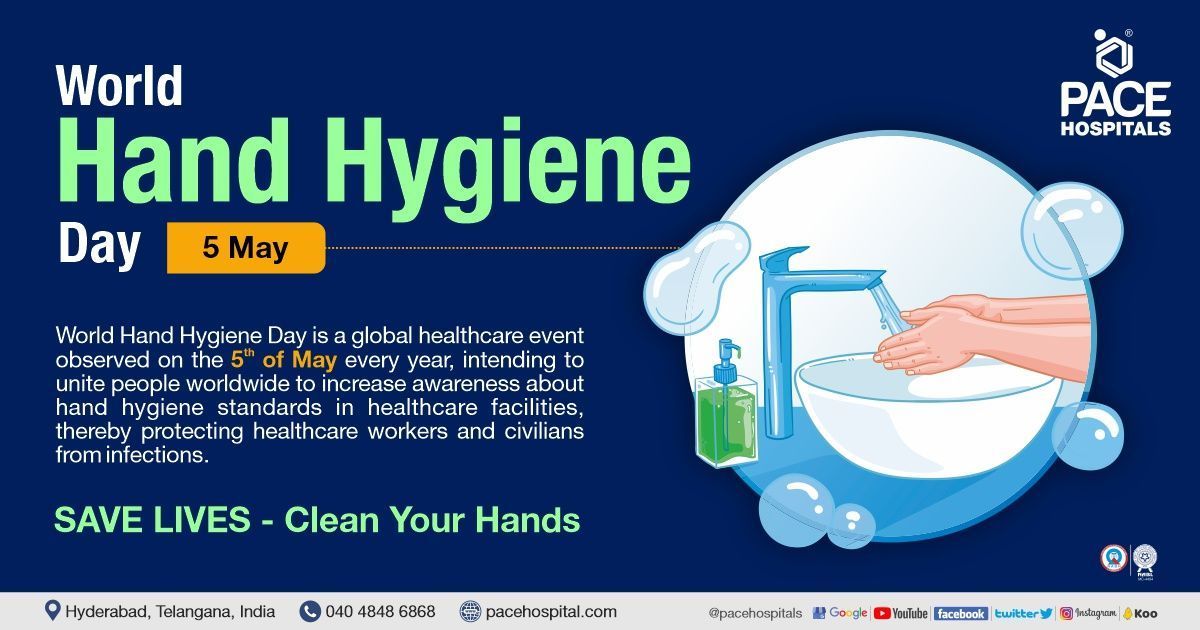
Our Locations
Subscribe to our newsletter and stay updated with the latest health information.
By clicking on subscribe now, you accept to receive communications from PACE Hospitals on email, SMS and Whatsapp.
Subscribe to PACE Hospitals News
Thank you for subscribing. Stay updated with the latest health information.
Oops, there was an error. Please try again submitting your details.
-

Payment in advance for treatment (Pay in Indian Rupees)
For Bank Transfer:-
Bank Name: HDFC
Company Name: Pace Hospitals
A/c No.50200028705218
IFSC Code: HDFC0000545
Bank Name: STATE BANK OF INDIA
Company Name: Pace Hospitals
A/c No.62206858997
IFSC Code: SBIN0020299
Scan QR Code by Any Payment App (GPay, Paytm, Phonepe, BHIM, Bank Apps, Amazon, Airtel, Truecaller, Idea, Whatsapp etc)
Call us at 04048486868
ADDRESS
PACE Hospitals
Hitech City : Beside Avasa Hotel, Pillar No. 18, Hyderabad - 500081
Madinaguda: Mythri Nagar, Beside South India Shopping, Madinaguda, Hyderabad - 500050
QUICK LINKS
Disclaimer
General information on healthcare issues is made available by PACE Hospitals through this website (www.pacehospital.com), as well as its other websites and branded social media pages. The text, videos, illustrations, photographs, quoted information, and other materials found on these websites (here by collectively referred to as "Content") are offered for informational purposes only and is neither exhaustive nor complete. Prior to forming a decision in regard to your health, consult your doctor or any another healthcare professional. PACE Hospitals does not have an obligation to update or modify the "Content" or to explain or resolve any inconsistencies therein.
The "Content" from the website of PACE Hospitals or from its branded social media pages might include any adult explicit "Content" which is deemed exclusively medical or health-related and not otherwise. Publishing material or making references to specific sources, such as to any particular therapies, goods, drugs, practises, doctors, nurses, other healthcare professionals, diagnoses or procedures is done purely for informational purposes and does not reflect any endorsement by PACE Hospitals as such.

